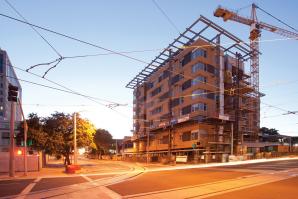Is the master-planned community dead? Earlier this year, the Los Angeles Times painted the picture for homebuilders quite clearly when it posed that question.
The ultimate answer was maybe. In California, and particularly in the Capital Region, there’s no debate. The proposals for 100- and 300-home tracts of the past are gone, and by all accounts they won’t be back for a long time. Those built between 2006 and 2009 still have inventory that could take anywhere from one to five years to sell.
Still, new home projects are being built. The difference is scale: small clusters here and there, tucked into existing neighborhoods and urban infill areas. Call them mini-planned developments.
An early-millennium version of those projects might have as many as 50 homes, but developments now are coming online with fewer than 20. The builders behind them are doing what any smart business does: adapting to the market; targeting consumer groups carefully and building homes that cater to specific preferences. They’re few in number, but they’re what builders can still make work.
For starters, numbers are on their side.
Developers are in a great position to take advantage of distressed properties,” says Budd Brumbaugh, regional sales director with Hanley Wood Market Intelligence. “They can deal directly with the banks and pick up small pieces of land from other developers that have left town.”
Active builders are also finding a warm reception from lenders, who seem to like these smaller infill projects. The fact that they’re in established neighborhoods lowers the perceived risk. Also, consumer demand and preference for new homes, especially in existing neighborhoods, never went away. Couple that with lower overhead due to existing infrastructure, and these projects are attractive even as lending remains tight.
Support from local governments doesn’t hurt either.
“When it comes to permits and fees, the process isn’t only faster, the cost is a lot lower with smaller infill projects,” says Tim Lee, vice president of operations for Tower Development Corp. in Sacramento. “Traffic and sewer impacts are minimal and don’t require new infrastructure, so total costs for urban infill projects are about a third to half of what you might pay in suburban areas.”
As good as the numbers are on the investment side, what makes
everything possible is the healthy demand for new homes.
“Usual weekend traffic through a development is about 25 people,
according to industry reports,” says Kevin Carson, president of
The New Home Co. in Roseville. “Our project in Granite Bay is
getting 95 to 100.”
That’s an exception, but across the board developers of small projects say they are pleased with the level of interest they’re seeing. Larger projects in the region are seeing decent traffic as well, but developers of the mini projects think they have an edge.
“I think people are sick of seeing the long street of 90 houses that all look the same, and they’re looking for a neighborhood that has a sense of variety and character,” Carson says. “We’re going for a whole different look and feel, like you might see in East Sac or Davis, where you can drive down the street and not think one builder put up all those houses.”
As for what’s driving demand for new homes, particularly in established areas, it comes down to two maxims: Newer is better; and the price of gas is too high.
As Carson puts it, there’s a constant market of people who have been in their homes for 15 to 20 years. Their home warranties have expired, stuff is starting to leak and creak, and owners fear they’re soon going to find themselves on the unpleasant side of a major repair or remodel.
“It’s like a car,” he says. “At some point you have to decide if you’re going to keep paying to have it fixed, or just go out and buy a new one.”
Energy efficiency and the subsequent cost savings are another advantage of going new. Homeowners can control their lights and air conditioners from their iPhones and take advantage of the latest energy-efficient appliances and technology. A home built in 1990 — long before high-tech became a regular part of builders’ tool boxes — just can’t compete. The choice between a brand-new home or retrofitting an older home quickly becomes easy.
“A new home is the most energy-efficient home you can buy,” says John Stewart, principal with Premier United Communities. “They’ve got all the newest appliances, energy-efficient construction and the added benefit of no need to replace anything in the next five years.”
Equally applicable is consumers’ taste for cleaner, greener living. Most of today’s homes are built with the environment in mind, and say what you will about climate change, people tend to like thinking their lifestyles are helping address a problem.
Moreover, anyone wanting to live in places such as Granite Bay, Roseville, Fair Oaks or other communities with reputations for safe neighborhoods, great schools, nice parks and amenities, hasn’t had the option for a new home in those areas in roughly a decade. To have a sparkling new home with the advantages of an older, established and prestigious community is the best of all worlds.
Finally, the concept of walkable communities, or “walkability” — which simply relates to how readily accessible community amenities are on foot — has been growing in popularity, particularly as gas climbs above $4 a gallon again.
“I think we’re going to continue to see a movement toward higher density, especially around transit corridors and mass transportation,” Lee says.
The old adage that Americans are the only people who will ride up to the poor house in their own automobile remains true, but so does the law that retail follows rooftops.
“There are master-planned communities out there still waiting for more rooftops to come in before the commercial places will arrive,” Carson says. “I think people are looking for a home that’s close to existing restaurants and shops, churches and entertainment and don’t want to wait around for those to be built.”
Homebuyers may not really walk everywhere, but again, if they can feel like they’re helping the environment by driving less, and they’re putting money in their pocket instead of the gas tank, it’s one more advantage the mini-planned community offers.
Recommended For You

Putting the Fab in Pre-Fab
Modular construction cuts construction and energy costs
The final stages of construction at a trend-setting apartment project in San Francisco’s SoMa neighborhood, known by its address at 38 Harriett St., largely resembled a life-sized game of Tetris.

Mind the Gap
Finding new ways to fund affordable housing
Sacramento County will need an estimated 23,000 low- and very low-income housing units in the next nine years. The six-county region stretching from Yuba to Placer to El Dorado would need more than 41,000 units. But without the tax increment financing once provided by redevelopment agencies, city leaders are wondering where they’re going to come up with the cash to build.



